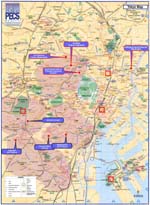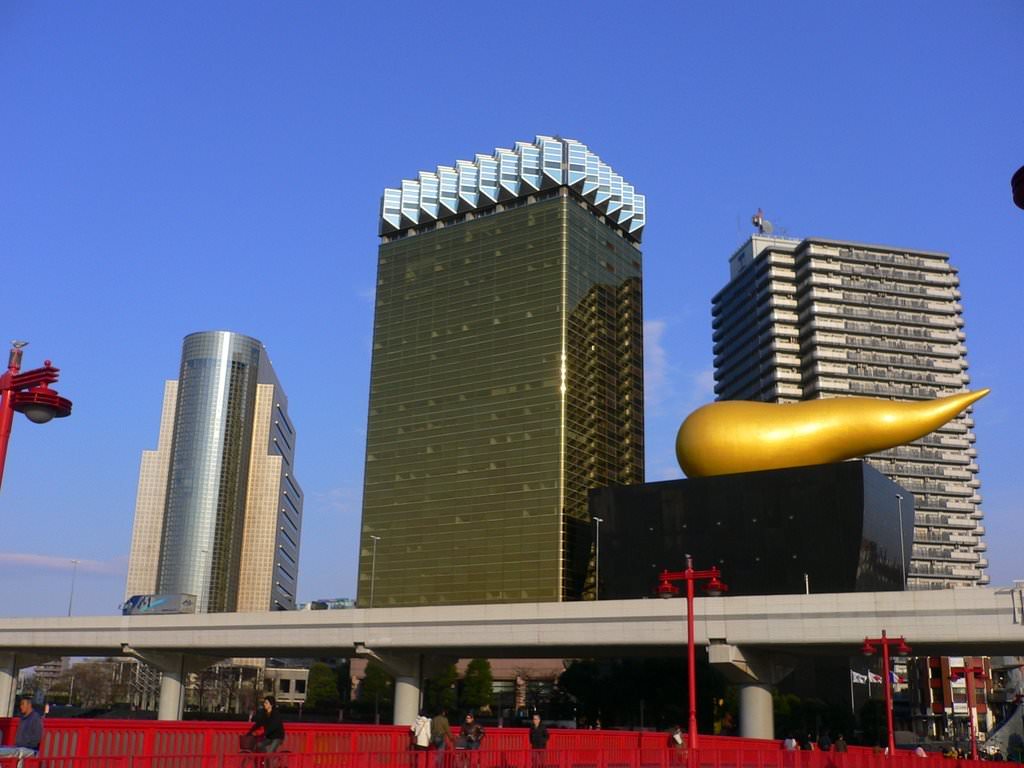Top architectural sightseeing and landmarks of Tokyo - ideas on city exploration routes
Video of flights over top monuments of Tokyo in HD format.
Use 'Full Screen' mode.
Tokyo Tower, Tokyo
Location on the map:  Facts:
Facts:
» The height of Tokyo Tower is 332.6 meters, which at the time makes it the highest steel structure in the world. » The Tokyo Tower is in the list of 29 highest object of the World Federation of Great Towers ranked 14th of them.
» Today the tower is rather a tourist attraction; it’s considered one of the symbols of Tokyo.
» TV Tower houses an observation deck, halls and museums. Beneath the tower there is the 4-story building that is occupied by shops in addition to museums and restaurants.
» Observatories can be found at an attitude of 145 and 250 meters. The lower observatory occupies two floors.
» At the dawn 176 spotlights illuminating the entire tower from the ground to its antenna begin working.
Metropolitan Government Building, Tokyo
Location on the map:  Facts:
Facts:
» The Metropolitan Government Building is the skyscraper that houses the Tokyo metropolitan government. » The height of the building is 243 meters. Since its completion in February 1991 to January 2007 it was the tallest building in Tokyo.
» The Metropolitan Government Building is the complex of three buildings combined into a single architectural composition. All three buildings are linked by narrow bridges.
» The exterior and interior of the Metropolitan Government Building have elements that resemble computer chips.
» All buildings were constructed using special earthquake-resilient technologies that will withstand the 8-magnitude earthquake.
» The Metropolitan Government Building can boast ultra-silent elevators that take visitors to the 240-meter height in one minute.
Tokyo National Museum, Tokyo
Location on the map:  Facts:
Facts:
» The Tokyo National Museum is the huge cultural center, which is the oldest and largest museum in Japan. » Currently the collection of the Tokyo National Museum consists of about 120 thousand items. Among them are paintings, calligraphy, sculpture and metalwork, weapons, military armor, ceramics, lacquer, fabrics, models of architectural monuments and archaeological, historical and ethnographic material, the set of thematic publications and photographic materials.
» The main building of the museum contains works of fine and applied arts, as well as historical and ethnographic materials on the development of Japanese culture from ancient times to the present with all its features.
» It’s used as a museum and educational center, where meetings of various scientific societies and regular seminars are held.
» The East building represents works of fine and applied arts, as well as archaeological finds of all countries of the eastern region excluding Japan.
» Heisei case stores Japanese antiquity and keeps the treasures of Horyu-Ji temples.
Olympic Stadium, Tokyo
Location on the map:  Facts:
Facts:
» The Olympic Stadium Tokyo is able to accommodate 60,057 spectators. » The Stadium is the home arena of the Japan football team.
» In 1964, the National Olympic Stadium was the main stadium of the Summer Olympic Games in Tokyo.
» In 1991, the stadium held the World Cup athletics, and from 1980 to 2000 the Olympic Stadium in Tokyo held the Intercontinental Cups in football.
» In 2020, Tokyo will host XXXII summer Olympic Games, and the Olympic Stadium is likely to be the main arena of the Olympic Games once more.
Shinjuku Park Tower, Tokyo
Location on the map:  Facts:
Facts:
» Shinjuku Park Tower is skyscraper of 265 meters in height. » Shinjuku Park Tower is the main administrative and commercial center of Tokyo.
» The tower consists of three elements: Tower S of 235 meters (52 floors), Tower C of 209 m (47 floors) and Tower N of 182 m (41 floors).
» Floors 1st through 8th are used for shops, floors 9th to 37th are occupied by office space, and 39th to 52th floors house the luxurious hotel Park Hyatt Tokyo.
Senso-Ji, Tokyo
Location on the map:  Facts:
Facts:
» Senso-Ji is the old Buddhist temple. According to the legend it was founded in 628 on the site of the discovered statue of Bodhisattva Kannon. » The old shopping street Nakamise-dori is close to the temple; in many shops you can buy sweets and souvenirs.
» Local residents were allowed to trade here since the early 18th century.
» Annually the colorful fair Hagoita ichi, where you can buy the famous Japanese hagoita racket, is held in the shrine. Hagoita rackets are no longer used for games. Recently, they are used for interior decoration.
» In addition, the fair features a variety of shuttlecocks, kites and numerous New Year's goods and souvenirs.
This guide to architectural sightseeing in Tokyo is protected by the copyright law. You can re-publish this content with mandatory attribution: direct and active hyperlink to www.orangesmile.com.
City tours, excursions and tickets in Tokyo and surroundings
Build your walking routes in Tokyo on the landmark map
Thailand Relaxes Its COVID-19 Policy
New Year events in Thailand are likely to bring more people this year because everyone is tired of lockdowns and craving normal life. Many tourists, who book hotels in Pattaya, Krabi, or Phuket for the holiday season, also want to participate. As champagne has become an essential drink for New Year celebrations, the question regarding alcohol consumption comes to mind. The government allowed serving alcoholic drinks during the New Year countdown but only open-air cafes and restaurants with good ventilation will be permitted to do this until 1 am on 1 January 2022. This rule is nationwide. Read this
Read this
27.07.2024
New Year events in Thailand are likely to bring more people this year because everyone is tired of lockdowns and craving normal life. Many tourists, who book hotels in Pattaya, Krabi, or Phuket for the holiday season, also want to participate. As champagne has become an essential drink for New Year celebrations, the question regarding alcohol consumption comes to mind. The government allowed serving alcoholic drinks during the New Year countdown but only open-air cafes and restaurants with good ventilation will be permitted to do this until 1 am on 1 January 2022. This rule is nationwide.
27.07.2024


 English
English Russian
Russian Dutch
Dutch German
German Spanish
Spanish French
French Türkçe
Türkçe




















